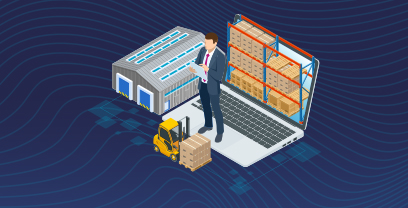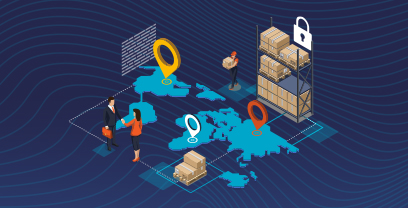Supplier networks are no longer just a way to manage transactions; in recent years, they’ve transformed into dynamic, strategic ecosystems that fuel business growth, innovation, and resilience.
Unlike traditional supplier networks that were often limited to transactional exchanges and manual processes, modern supplier networks leverage advanced technologies like AI, real-time analytics, and IoT, enabling businesses to respond faster to market changes and anticipate risks..
A well-designed supplier network enhances visibility and accountability throughout the supply chain – a critical capability in today’s world of complex global sourcing, the participants of which increasingly demand transparency.
In this blog, we’ll take an in-depth look at supplier networks, and explain how supplier portals are transforming procurement by enhancing transparency, supply chain efficiency, and supplier relationships.
Key Takeaways
- Modern supply chains require more than traditional supplier networks that may lack real-time visibility, create data silos, and hinder collaboration with suppliers.
- Supplier portals streamline procurement by centralizing communication, automating workflows, and providing real-time insights that improve efficiency, transparency, and supplier
performance. - Managing supplier relationships directly, rather than through third-party networks, allows you to onboard vendors faster, enhance data security, and build stronger partnerships with your vendors.
Types of Supplier Networks
Supplier networks come in various forms, each offering distinct benefits and suited to different procurement needs. Here’s an overview:
- Open Supplier Network: Allows any supplier to join with minimal restrictions. Broad access is beneficial for companies looking to explore diverse sourcing options quickly and without the barriers of a formal vetting process. However, with openness comes variability in supplier quality and compliance, which requires more oversight.
- Closed/Private Supplier Network: Restricts access to select, pre-approved suppliers based on specific criteria, such as quality standards, compliance, or industry certifications. This selective approach allows companies to maintain tighter control over supplier quality and performance.
- Centralized Supplier Network: Managed by a single organization or platform that oversees all supplier relationships and transactions. This model offers streamlined coordination, simplified processes, and a single point of data collection, for a cohesive view of supplier activities and performance.
- Decentralized Supplier Network: Often facilitated through blockchain, these networks eliminate the need for a central authority. Participants interact directly, benefiting from transparent, secure transactions and the integrity that blockchain technology provides. They’re ideal for industries prioritizing security, transparency, and independence.
- Collaborative Supplier Network: Enables buyers and suppliers to co-create value, share resources, and drive innovation. This approach builds deeper partnerships where suppliers and buyers align on goals, and develop a culture of continuous improvement that benefits the entire supply chain.
Read our Vendor Management Blog to learn how effective supplier information management can streamline stakeholder responsibilities and help you stay organized and efficient.
Challenges With Traditional Supplier Networks
Traditional supplier networks often face significant challenges that limit efficiency and undermine collaboration between companies and their suppliers.
One of the biggest drawbacks of legacy procurement systems is the lack of real-time visibility. In fact, according to Deloitte, over 65% of procurement leaders report limited visibility into supplier performance.
Without real-time updates, companies struggle to monitor order statuses, track supplier compliance, or respond to unexpected changes in demand, which can lead to costly delays or quality issues. At the same time, suppliers need to contact the organization each time they want insight into delivery or payment status, resulting in added workload.
Another prevalent issue is the reliance on manual processes and data silos. Many traditional networks use fragmented systems, spreadsheets, or emails to track supplier information, making it challenging to maintain accurate data.
This siloed approach not only increases the risk of errors and wastes valuable time – Ivalua’s research suggests procurement professionals spend up to 31% of their time on redundant manual tasks. Manual work doesn’t just waste time; it hinders the flow of communication across multiple vendors, creating delays, misinterpretations, and inconsistencies.
Data security risks are another significant issue, as older systems often lack the robust cybersecurity needed to protect sensitive supplier data. Additionally, integrating traditional networks with newer technologies can be complex, limiting scalability and adding to maintenance costs.
Supplier resistance to digital adoption also poses challenges; when vendors are required to pay third parties to submit invoices, it can create friction and harm relationships by adding extra fees.
A further drawback of traditional networks is their indirect connection between companies and suppliers, limiting collaboration and eroding trust. According to Gartner, “Organizations leveraging digital supply chain ecosystems gain greater flexibility and resilience.”
Modern supplier portals, unlike traditional networks, foster direct engagement and smoother interactions, helping businesses pivot quickly and reduce risks during disruptions.
Supplier Portals – Changing the Game for Modern Procurement
A supplier portal is a digital platform that streamlines supplier management by enabling suppliers and buyers to interact seamlessly within a single interface. Key features include workflow automation, self-service capabilities, and real-time dashboards that offer visibility into supplier performance, compliance, and procurement optimization metrics.
Supplier portals enhance efficiency and reduce manual work, simplifying supplier management with procurement automation and reducing the need for constant follow-ups. They empower suppliers to submit invoices, check payment statuses, and update their information on their own.
According to Gartner, “By automating procurement and supplier management processes, supplier portals reduce transaction costs and eliminate inefficiencies.”
Key Differences Between Supplier Networks and Supplier Portals
While supplier networks connect a broader ecosystem of suppliers and buyers, a supplier portal offers a centralized, company-specific platform focused on direct supplier relationships.
For example, supplier networks are ideal for sourcing new vendors across industries, while supplier portals support ongoing management and collaboration with established suppliers.
Key benefits of supplier portals include:
- Automation & Efficiency: Workflow automation to reduce manual tasks, and self-service capabilities for suppliers.
- Transparency & Real-Time Insights: Visibility across the supply chain, allowing for performance tracking and supplier risk mitigation.
- Enhanced Supplier Relationship Management (SRM): Proactive communication and early issue detection to strengthen supplier relationships and facilitate supplier performance management.
5 Reasons Why Companies Should Rethink Supplier Networks
While traditional supplier networks offer some benefits, they often come with limitations. Here’s why building direct, independent connections with your suppliers can make all the difference:
1. Your Supplier Relationship Is Yours Alone: When your suppliers are part of an external network, you’re forced to rely on the policies, fees, and changes made by the network provider. Who manages the flow of information? Who sets terms and conditions?
When network vendors adjust fees or impose new terms, your relationship with suppliers can be affected. Controlling your own supplier communications gives you direct access, transparency, and independence in managing these relationships.
2. Supplier Adoption = Flexibility: A common argument for large supplier networks is that having thousands of suppliers already on the platform should expedite onboarding. In practice, that’s often not the case. The real driver of supplier adoption is the ease and flexibility for suppliers to connect, without additional fees or contractual limitations.
Suppliers are more likely to join if onboarding is seamless and doesn’t require them to navigate legal reviews or pay extra fees. Ivalua customers like CACI (with 99.8% of suppliers onboarded), Fannie Mae (70,000 suppliers), and Credit Agricole (nearly 60,000 suppliers in a paperless system) achieved these results by using private networks. Maxim Healthcare onboarded more suppliers in just two months with Ivalua’s private network than they had with their previous network over seven years. Check out the case study here.
3. Your Suppliers Will Thank You: A direct relationship fosters collaboration, especially when companies look to suppliers for innovation and value beyond cost savings. By cultivating this relationship, you position yourself as a preferred customer and maximize the value you derive from the supply chain, allowing suppliers to add value beyond just price.
4. Data Security Is Important: Centralized supplier networks can be vulnerable to data breaches (think of Cambridge Analytica, Yahoo, and Equifax) and become high-value targets for hackers. Additionally, supplier networks often operate through the base country of the provider, potentially exposing your data to varied regulations and risks. Decentralized solutions like blockchain offer a promising alternative by reducing single points of failure. Maintaining data security in supplier communications helps protect your operations – and your reputation.
5. The Economy Is Changing – Stay Agile: As consumer preferences shift away from major social platforms, businesses must stay adaptable, as well Managing your own supplier relationships allows you the flexibility to pivot as the networked economy evolves.
For a deeper dive into optimizing supplier partnerships from the start, be sure to read our blog on effective supplier onboarding.
Case Study: Procurement Transformation Enabling Streamlined And Automated Processes
Grupo Antolin faced significant challenges with its legacy procurement systems, including limited visibility into supplier risk, compliance, and sustainability, as well as manual data entry requirements that slowed down sourcing and procurement. Supplier adoption was becoming increasingly difficult, and the inability to integrate with systems like Teamcenter prevented the inclusion of critical data such as 2D/3D files and sustainability metrics.
The organization partnered with Ivalua to modernize and future-proof its direct materials procurement systems. They wanted to improve agility, take advantage of automation, and enhance collaboration both internally and with suppliers. The company successfully automated procurement workflows and improved collaboration and published over 2,500 sourcing events. They now manage more than 40,000 suppliers and 1200 contracts effectively.
“With Ivalua, our organization has improved collaboration both internally and externally with suppliers, automated processes and greatly improved our visibility across the end-to-end direct materials procurement process.”
– Beatriz Jimenez Benito Control & Systems Purchasing Director, Antoli
Read the full case study.
Streamline Supplier Management with Ivalua
Optimizing supply chains with supplier portals offers far greater efficiency, compliance, and collaboration than traditional networks can provide. By centralizing supplier interactions, automating processes, and providing real-time insights, supplier portals empower procurement professionals to build stronger, more resilient supply chains.
Ivalua’s supplier management and supply chain collaboration software provides a comprehensive solution for managing every stage of the supplier lifecycle. It enables:
- Clear, automated processes to integrate new suppliers quickly and efficiently.
- Simplified performance management through real-time monitoring with KPIs such as delivery times and compliance rates.
- AI-driven insights to leverage historical trends for smarter decision-making.
- Advanced analytics to enhance supply chain collaboration, with real-time dashboards that track risk, performance, and collaboration metrics.
All of this is accessible through Ivalua’s centralized supplier portal, designed with the needs of modern organizations in mind.
For companies looking to elevate their supplier relationships and procurement efficiency, Ivalua’s supplier management software provides a robust solution.
Watch our on-demand demo to experience the benefits and capabilities of Ivalua’s Supplier Management solution firsthand.
FAQs
What is a supplier network in procurement?
A supplier network is a connected ecosystem of suppliers and buyers that enables the exchange of information, goods, and services. In procurement, it facilitates sourcing, collaboration, and transaction management across multiple vendors.
How does a supplier network work?
Supplier networks operate through digital platforms that link buyers and suppliers, allowing them to share data, manage orders, and communicate efficiently. Depending on the type (e.g.open, closed, centralized, decentralized, or collaborative) networks vary in access, control, and integration capabilities.
How does Ivalua support supplier networks?
Ivalua enables organizations to build and manage flexible, company-specific supplier networks that streamline onboarding, automate procurement processes, and enhance supplier collaboration. Its platform supports both centralized control and scalable engagement across thousands of suppliers without third-party fees or restrictions.
What is the difference between a supplier network and a supplier portal?
A supplier network connects a broad group of buyers and suppliers across organizations, often through a shared third-party platform. In contrast, a supplier portal is a company-specific digital interface that allows direct interaction with suppliers, offering greater control, automation, and transparency in supplier management.
Further Reading
- Supplier Management Datasheet
- The Forrester Wave™: Supplier Value Management Platforms, Q3 2024
- Supplier Lifecycle Management (SLM) Explained: From Onboarding to Collaboration
- Supplier Enablement: How to Empower Suppliers for Mutual Growth
- Ultimate Guide to Supplier Performance Management (SPM)
- Vendor Management in the Digital Age: Embracing Automation and AI




